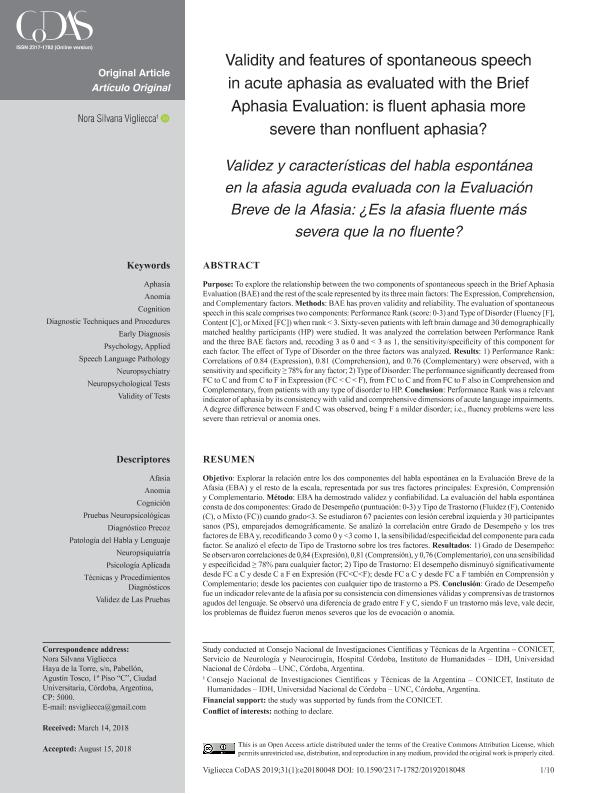Artículo
To explore the relationship between the two components of spontaneous speech in the Brief Aphasia Evaluation (BAE) and the rest of the scale represented by its three main factors: The Expression, Comprehension, and Complementary factors. Methods: BAE has proven validity and reliability. The evaluation of spontaneous speech in this scale comprises two components: Performance Rank (score: 0-3) and Type of Disorder (Fluency [F], Content [C], or Mixed [FC]) when rank < 3. Sixty-seven patients with left brain damage and 30 demographically matched healthy participants (HP) were studied. It was analyzed the correlation between Performance Rank and the three BAE factors and, recoding 3 as 0 and < 3 as 1, the sensitivity/specificity of this component for each factor. The effect of Type of Disorder on the three factors was analyzed. Results: 1) Performance Rank: Correlations of 0.84 (Expression), 0.81 (Comprehension), and 0.76 (Complementary) were observed, with a sensitivity and specificity ≥ 78% for any factor; 2) Type of Disorder: The performance significantly decreased from FC to C and from C to F in Expression (FC < C < F), from FC to C and from FC to F also in Comprehension and Complementary, from patients with any type of disorder to HP. Conclusion: Performance Rank was a relevant indicator of aphasia by its consistency with valid and comprehensive dimensions of acute language impairments. A degree difference between F and C was observed, being F a milder disorder; i.e., fluency problems were less severe than retrieval or anomia ones. Explorar la relación entre los dos componentes del habla espontánea en la Evaluación Breve de la Afasia (EBA) y el resto de la escala, representada por sus tres factores principales: Expresión, Comprensión y Complementario. Método: EBA ha demostrado validez y confiabilidad. La evaluación del habla espontánea consta de dos componentes: Grado de Desempeño (puntuación: 0-3) y Tipo de Trastorno (Fluidez (F), Contenido(C), o Mixto (FC)) cuando grado < 3. Se estudiaron 67 pacientes con lesión cerebral izquierda y 30 participantes sanos (PS), emparejados demográficamente. Se analizó la correlación entre Grado de Desempeño y los tres factores de EBA y, recodificando 3 como 0 y <3 como 1, la sensibilidad/ especificidad del componente para cada factor. Se analizó el efecto de Tipo de Trastorno sobre los tres factores. Resultados: 1) Grado de Desempeño: Se observaron correlaciones de 0,84 (Expresión), 0,81 (Comprensión), y 0,76 (Complementario), con una sensibilidad y especificidad ≥ 78% para cualquier factor; 2) Tipo de Trastorno: El desempeño disminuyó significativamente desde FC a C y desde C a F en Expresión (FC < C < F); desde FC a C y desde FC a F también en Comprensión y Complementario; desde los pacientes con cualquier tipo de trastorno a PS. Conclusión: Grado de Desempeño fue un indicador relevante de la afasia por su consistencia con dimensiones válidas y comprensivas de trastornos agudos del lenguaje. Se observó una diferencia de grado entre F y C, siendo F un trastorno más leve, vale decir, los problemas de fluidez fueron menos severos que los de evocación o anomia.
Validity and features of spontaneous speech in acute aphasia as evaluated with the Brief Aphasia Evaluation: Is fluent aphasia more severe than nonfluent aphasia?
Título:
Validez y características del habla espontánea en la afasia aguda evaluada con la Evaluación Breve de la Afasia: ¿Es la afasia fluente más severa que la no fluente?
Fecha de publicación:
03/2019
Editorial:
Revista Pro-Fono
Revista:
CODAS
e-ISSN:
2317-1782
Idioma:
Inglés
Tipo de recurso:
Artículo publicado
Clasificación temática:
Resumen
Archivos asociados
Licencia
Identificadores
Colecciones
Articulos(IDH)
Articulos de INSTITUTO DE HUMANIDADES
Articulos de INSTITUTO DE HUMANIDADES
Citación
Vigliecca, Nora Silvana; Validity and features of spontaneous speech in acute aphasia as evaluated with the Brief Aphasia Evaluation: Is fluent aphasia more severe than nonfluent aphasia?; Revista Pro-Fono; CODAS; 31; 1; 3-2019
Compartir
Altmétricas




